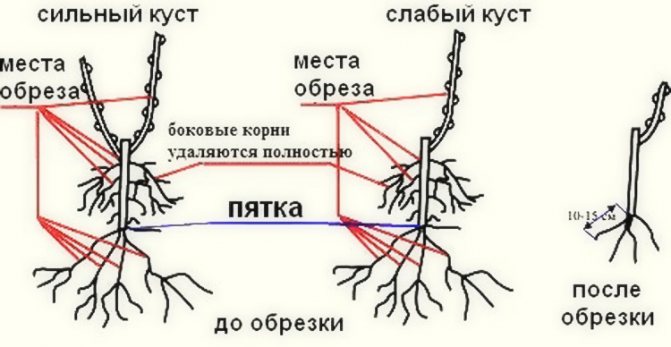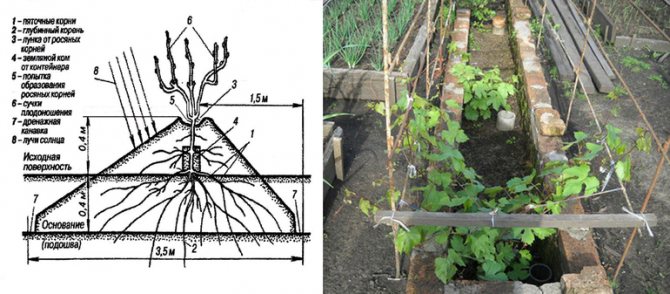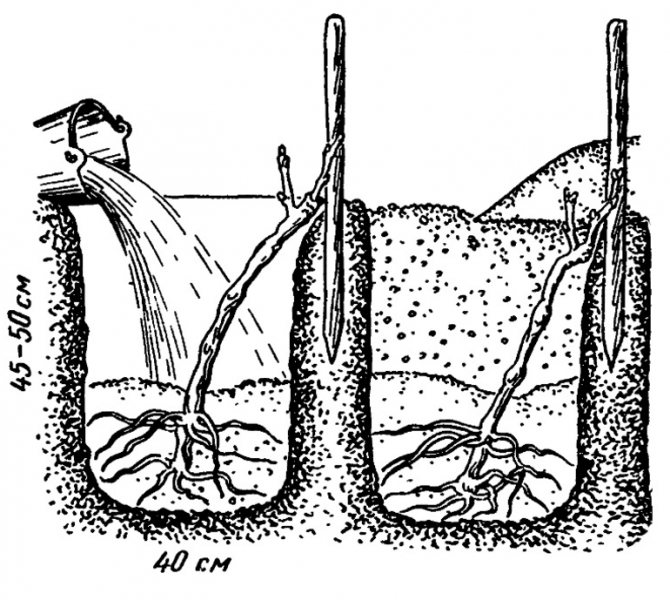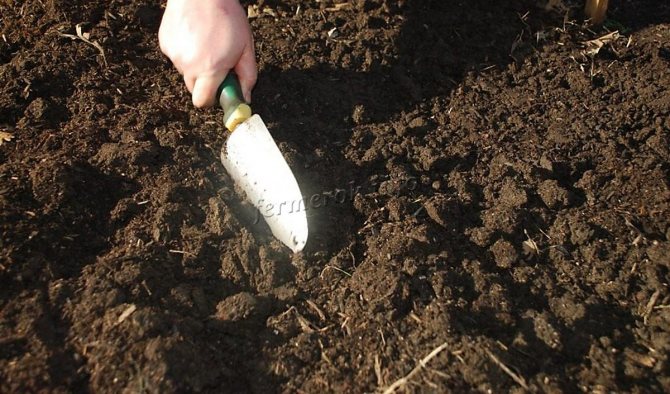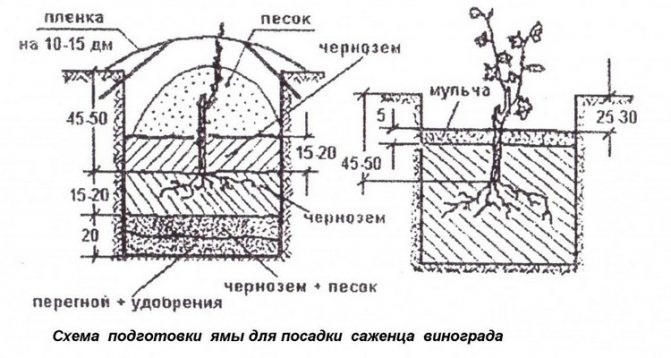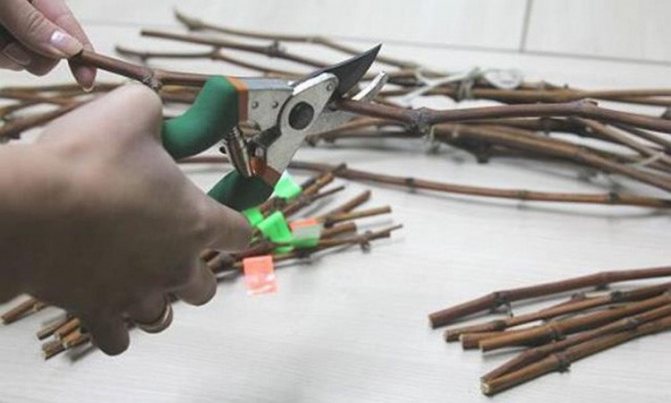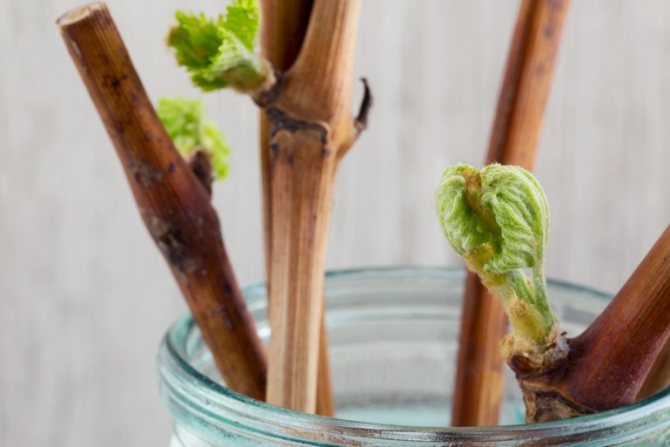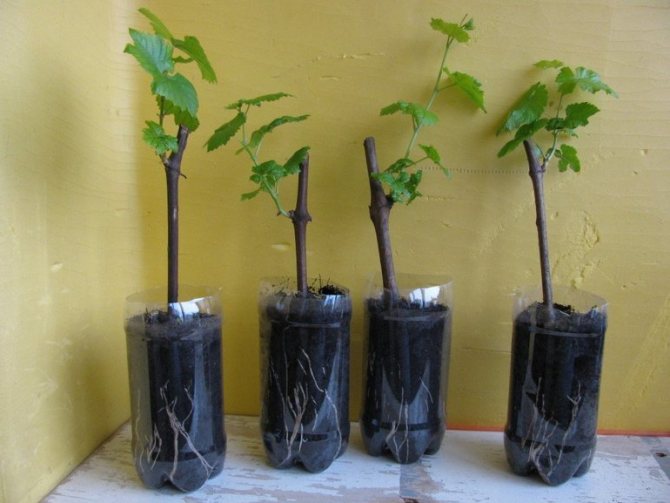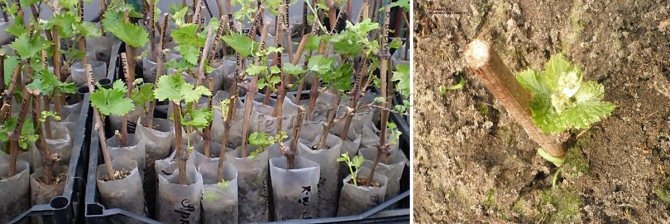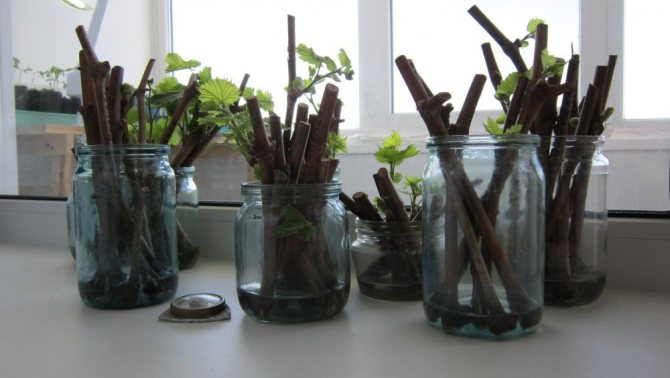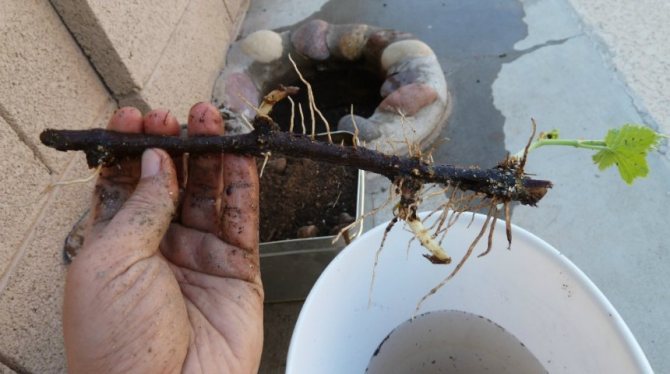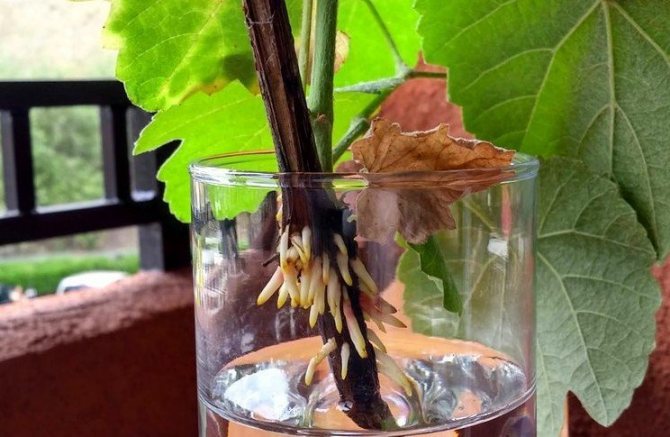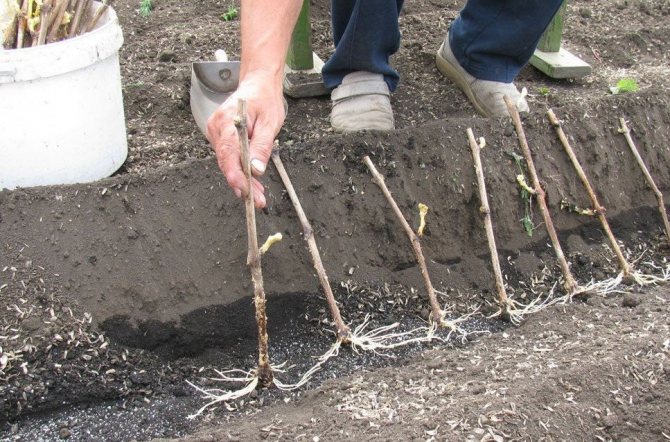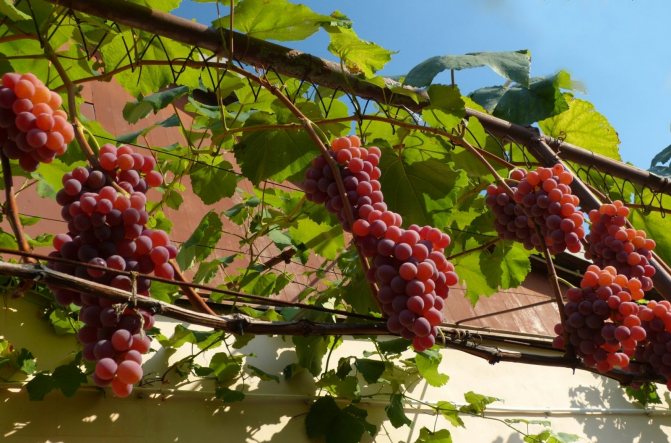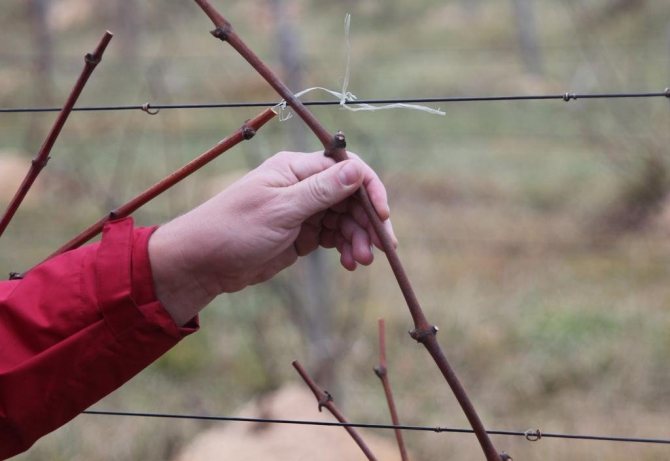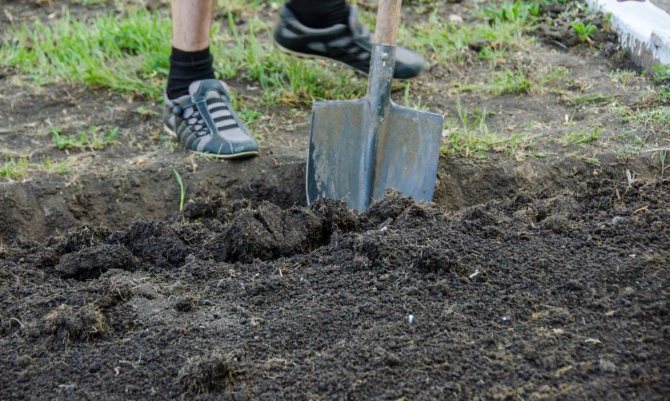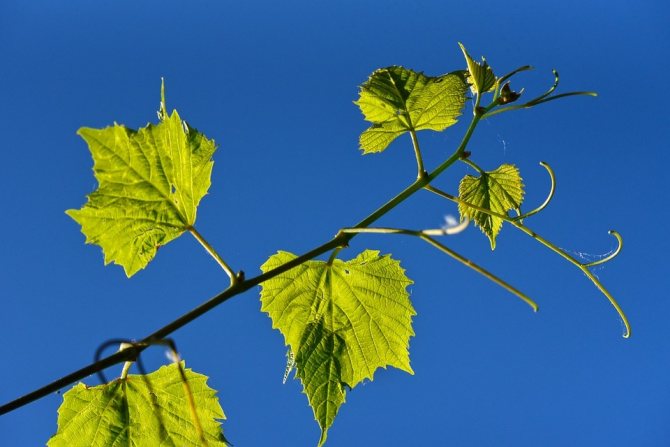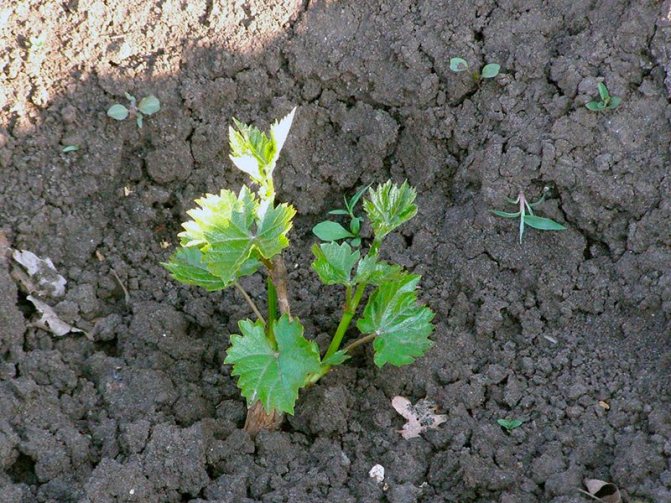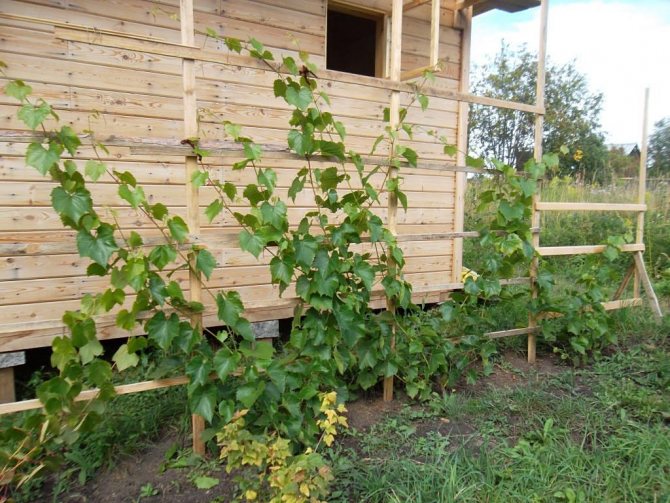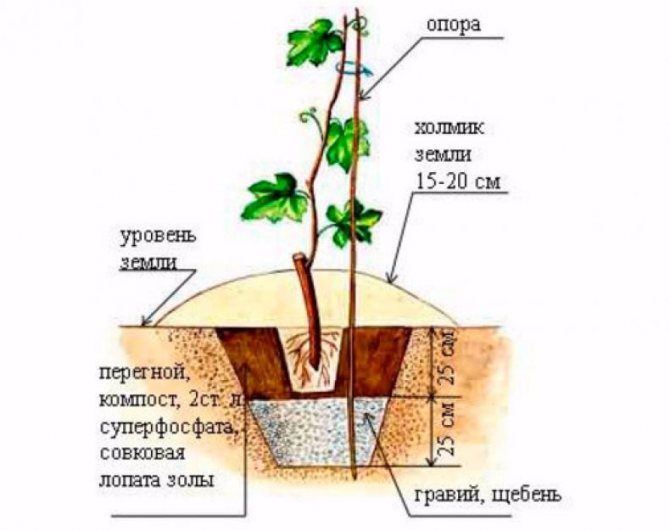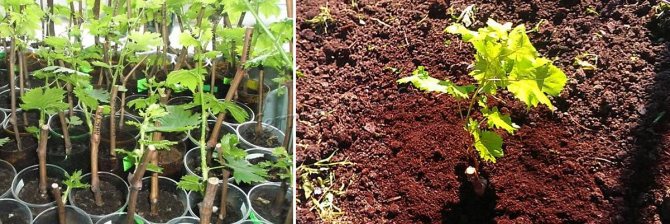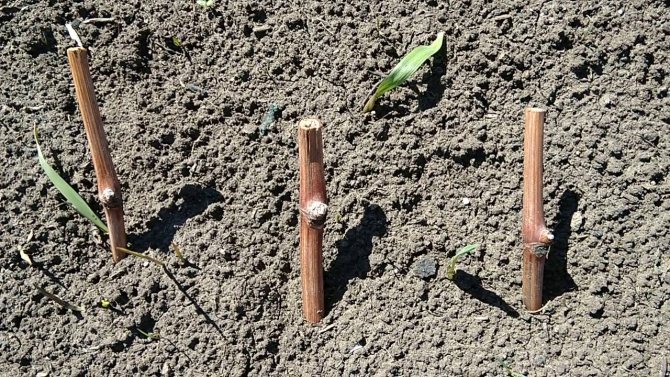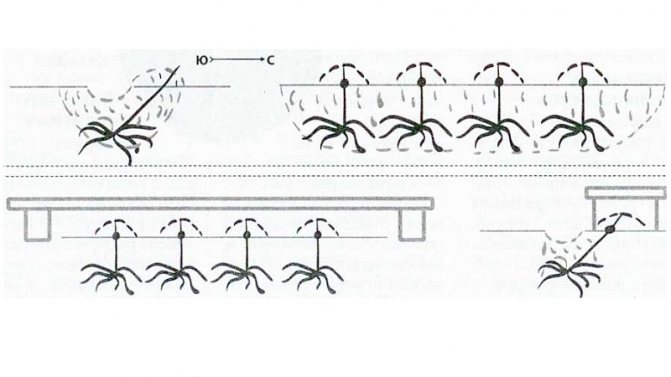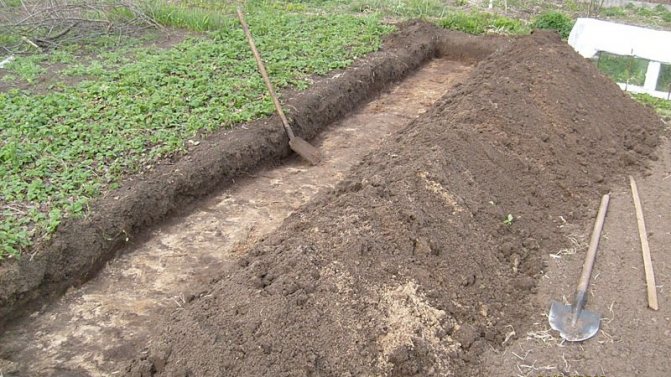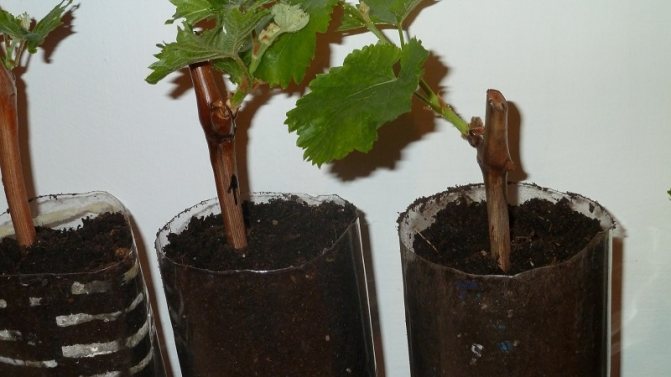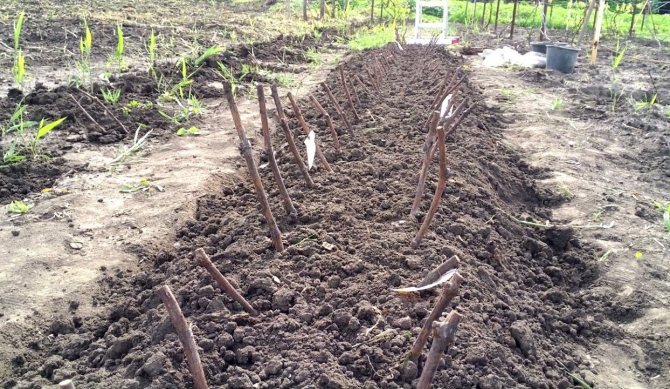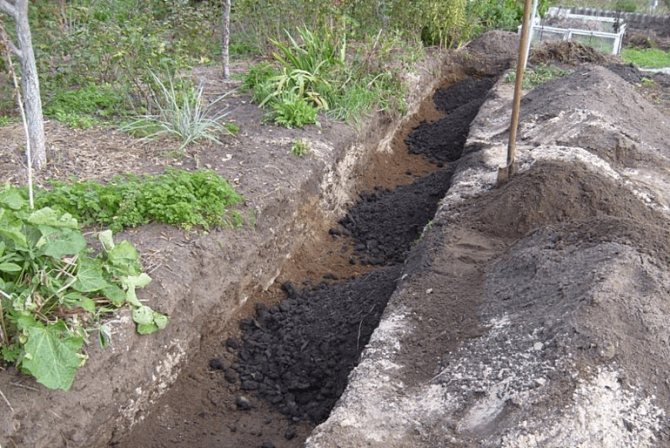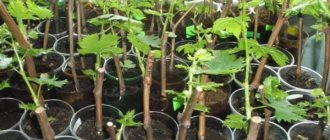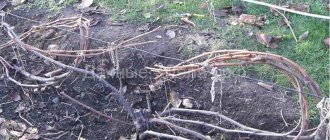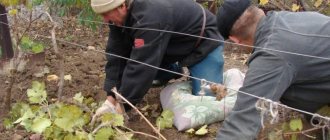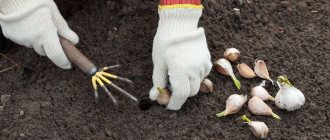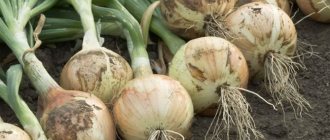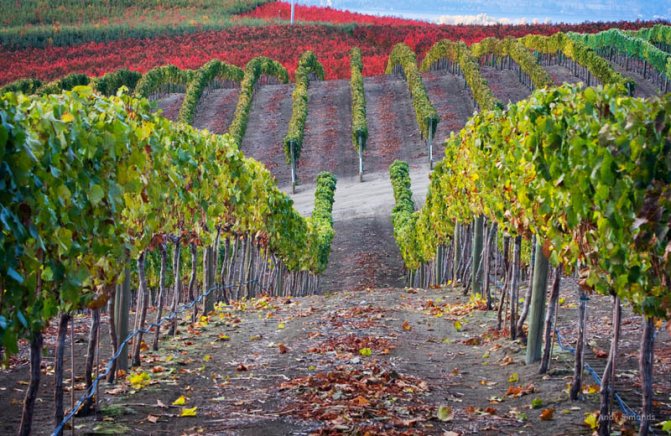
If a person is engaged in the cultivation of grapes, then the approach of the cold period sets him the task: how to plant grapes in autumn with cuttings. The cutting method of planting in the fall is recognized as a quick and cost-effective way of growing grapes. If you follow the planting rules and take good care of the plant, then the first bunches of grapes will delight the gardener by the end of the second year.
The choice of planting material
A novice grower should choose a grape variety, grafting of which is suitable for further cultivation in a given climatic zone. The following grape varieties are recognized as the most resistant to frost: maiden, Lydia, Rilins pink sidlis, codryanka, etc.
There are several methods of vegetation of grapes: planting by cuttings, removal of the vine, grafting. The most effective vegetative breeding method. The reception is based on the rapid healing of plant cells. Therefore, grapes quickly rehabilitate, heal wounds, and restore vitality after severe winter cold. You can get a healthy bush from a section of a stem that has a bud. Such an escape must be rooted, only then grown independently.
In the spring, such a bush will begin to actively develop. The main condition is to cut a better ripe vine, which should be about 1-1.2 m in length and 6-10 mm in diameter. In the fall, grape cuttings are taken from the vine, the ratio of the circumference of the trunk to the core is two. It is important to properly prepare the cut vine for planting at home.
Possible mistakes when planting grapes in autumn
Novice gardeners are haunted by common mistakes that prevent them from getting a good vineyard:
- purchase of seedlings of dubious quality with unripe vines or overly dried due to improper storage;
- the wrong choice of the place where to plant: in shaded areas or in the lowlands, young growth is dying;
- early planting before the soil cools down after a hot summer, 1.5 months before the first frost;
- excessive deepening of the plant, when all growth buds have fallen into the ground;
- inappropriate or missing shelter for the winter.
Preparing the cuttings for autumn planting
Planting any plant involves selecting healthy seedlings. Signs of a cuttings suitable for growing:
- A healthy cut of the root of the cutting has a clear whitish shade.
- If an annual sapling acts as a cutting, its cut has a rich green color.
- Grape cuttings in the fall should have strong eyes. You can feel their vitality with light finger pressure. In the case of shedding, cuttings with such shoots will upset their owner with a negative result.
The death of cuttings is due to insufficient air intake, followed by decay and drying. To avoid such troubles, consider step by step how grapes are cut in the fall:
- The formation of cuttings is preceded by cutting a vine 5-6 mm thick, about 35 cm long.
- The surface of each cutting should have about four buds.
- The harvesting of cuttings does not stretch for weeks, since the cut cutting begins to fade almost immediately. The vine is cut with a sharp object, then the shoot is placed in water for three 2-3 days.
- The cut area of the cuttings is smeared with soft paraffin, and the other end of the shoot is treated with Kornevin to accelerate the process of root emergence. You can root the cutting by leaving it in a solution that stimulates root formation for a day.
- After following all the recommendations, you can make a hole and plant grapes from fresh cuttings in the fall directly into the ground. It is better to prepare the soil in advance.
Cuttings, properly prepared in autumn, can withstand long-term storage. Such shoots can be planted in the ground in the spring. Storage involves preliminary bundling of cuttings and tight bandaging. Future seedlings hibernate underground. Some growers dig in the soil with a shovel, forming a trench, and place bundles of blanks there.
How to cut cuttings in the fall
Grapes are distinguished by their ability to instantly regenerate and restore sprouts... This feature allows you to grow a new full-fledged bush from a part of the stem with a bud on your own.


Timing
The time of harvesting material for cuttings depends on the region of cultivation.... Correctly cut out shanks for reproduction in the fall, after the foliage has fallen off, before the first morning frost.
Attention! In the southern regions, where non-sheltered viticulture is practiced, the shanks are harvested in the spring. In the rest - in the fall.
Pruning instruction
Cut grape cuttings from healthy mother bushes with excellent yields. To collect cuttings, the vine is cleaned of stepchildren and antennae.
High-quality planting material meets the following characteristics:
- the most even shoots with solid wood;
- absence of diseases (short nodes, necrosis and others);
- uniform color of the bark without inclusions and damage;
- lack of drying and bark color characteristic of the variety;
- stem thickness - from 6 to 9 mm, length - from 50 to 100 cm;
- a cut from the middle of the vine with 2-3 live buds.
Cutting the cutting is carried out with a clean, disinfected tool.... The cut is made obliquely, at an angle of 45 °, from top to bottom to the center of the bush. The lower incision is made as close to the eye as possible, and the upper one is 2-3 cm higher than the buds left.
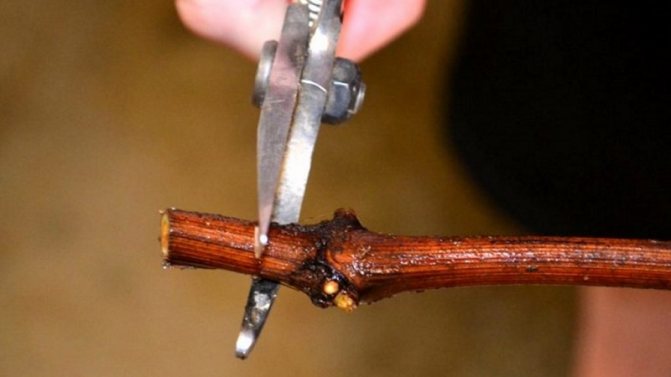

Choosing a soil for planting cuttings
It is important to plant grape cuttings in the fall in suitable soil. The main types of soils suitable for grape cuttings in autumn:
- Stony ground is able to absorb the attack of the sun's rays as much as possible. Great for growing grapes.
- Watery soil will destroy grape plants. Therefore, rooting cuttings requires frequent loosening of the soil. It is impossible to leave the soil without attention, the lack of oxygen will negatively affect the harvest.
- Planting grapes in sandy soils showed a quick survival rate, as well as high yields.
- Planting grape cuttings in the fall in black soil, you can observe the active growth of shoots the next year.
It is difficult to grow a solid vine without preliminary tillage. The earth is mixed with particles of red brick, chalk, humus, sand, river silt. The preparation of the soil composition for the autumn planting of cuttings is carried out according to the plantation method: the soil is thoroughly loosened, the fertilizers applied are quickly absorbed.
Choosing a plot for a vineyard
It is advisable to choose a site for a vineyard in the summer in order to prepare the soil for planting, apply fertilizers, prepare trellises or greenhouses for the autumn planting of grapes by cuttings.
To make the grape harvest pleasantly happy every year, you need to choose the right place for planting:
- the place should be on the sunny side, protected from strong winds;
- it is advisable to allocate the site away from irrigated crops and the old vineyard, in the land of which pests and painful spores could remain;
- place the trellises in a straight line "north-south" so that the bushes are illuminated by the sun all day;
- the vine must be ventilated, so it is worth planting it at a considerable distance from trees and other shrubs.
Grapes are considered an unpretentious shrub that grows in any soil, even rocky ones. He does not like a lot of water: the roots in such soil receive less oxygen, rot and die. Therefore, it is worth choosing a place where the groundwater is at the level of three meters and deeper.
How to properly prune dracaena for branching and caring for it
The soil is preferable fertile, light, not containing much moisture. If the soil is heavy, sand, compost, and fine gravel are added. On wetlands, it is necessary to first drain and raise the area higher.
A place for a vineyard is prepared in the summer, fertilizing and watering well, because without this, it will be impossible to plant grapes with cuttings in autumn. Without a sufficient amount of trace elements, minerals and microorganisms, they may not take root.
Planting cuttings in open ground
You can plant seedlings in rows, the harvesting of which occurs in advance. Trench tracks are made about one meter wide. You can help the plant to root the shoot in the ground by adding mineral impurities directly under the planting.
If you plan to cut young shoots and plant grapes with green cuttings, you should root the plant in the fall using the school method:
- The preparation of a trench in the ground is prepared ahead of time before planting.
- An earthen depression can be made about 20 cm.The distance between the trenches must be made spacious immediately, at least 45 cm.
- The base for rooting the cuttings is lined with rotted manure. Planting cuttings is carried out taking into account the immersion in the soil of a pair of buds of each shoot. Planting plants requires respecting the angle of inclination, as well as about 20 cm of distance between seedlings.
- At home, warm up the water a little, water the plants.
- Autumn can surprise you with early frosts. Therefore, the final rooting of cuttings can be carried out under a protective layer of polyethylene. It is customary to make an arched structure, the top of which is covered with a film. Cutting grapes in autumn provides for its preservation from night frosts. And such a structure is able to save the cuttings.
If it is not possible to build the proposed structure, you can simply cover the plants with spruce branches.
Planting instructions
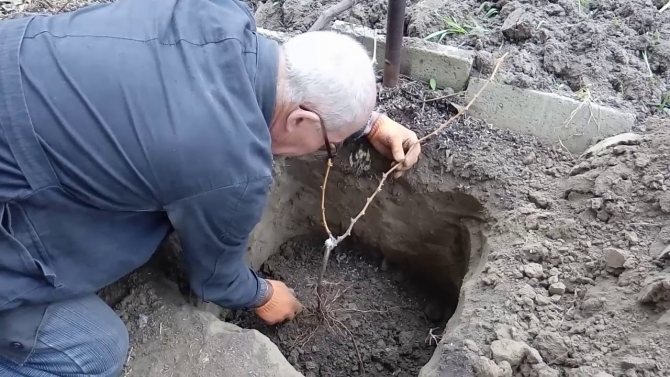

It is important to plant grapes deep enough to protect them from frost
You can get a new copy of a vine by planting a seedling, rooting a cuttings or a shank.
Saplings
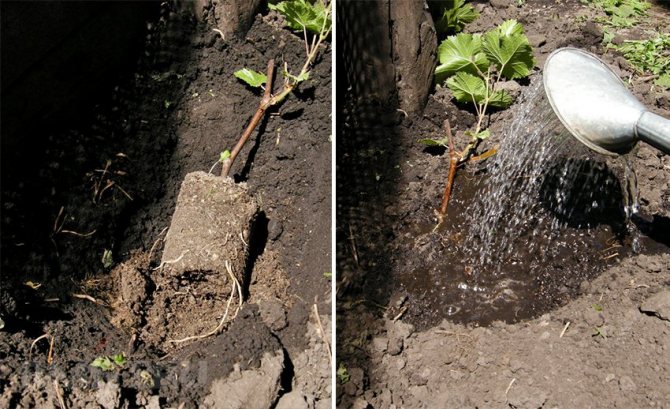

This method of planting requires preparing the pit in advance.
The first stage of planting grapes in autumn with seedlings is the preparation of a hole with a diameter and depth of 80 cm:
- First, the fertile layer with a height of 40 cm is removed, then the lower one. The soil is laid out in different directions.
- Drainage is laid at the bottom of the pit: broken brick, expanded clay.
- A nutrient mixture is prepared from the soil of the upper layer by mixing the following components into it:
- 3 buckets of humus or compost;
- 150 g of potassium salt;
- 250 g superphosphate;
- 2 kg of wood ash.
- A third of the pit is filled with the mixture and a bucket of water is poured out to settle the soil.
Planting is started in 2-3 weeks:
- A stake is installed in the center of the pit for the future garter of the shoot. A pile of nutrient mixture is poured next to it.
- A prepared seedling is installed on a hill of soil. The roots are placed at the edges at an angle of 45 degrees: this position will prevent them from bending up.
- The pit is gradually filled with soil, compacting each layer. The root collar of the seedling should be flush with the surface.
- After planting, the plant is watered abundantly, the surface is mulched with peat, humus or just dry soil.
Cuttings
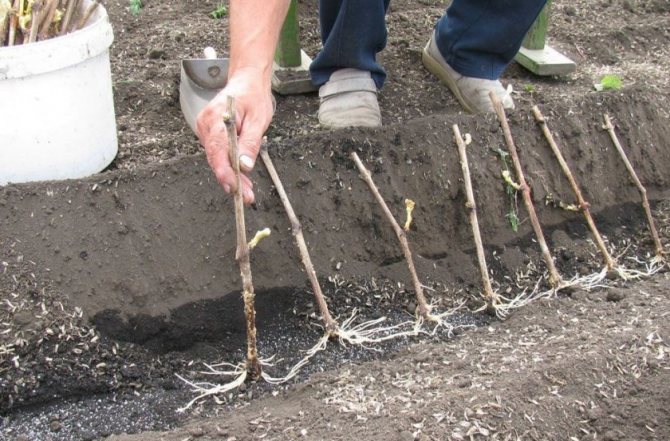

Cuttings need to be cooked during the summer pruning of grapes.
A stalk is a part of a vine that is cut into a different number of buds.Such planting material remains in abundance after summer pruning. As a rule, the most developed shoot is chosen and the upper part with 3-4 developed buds is cut off from it. Disembarkation sequence:
- Dig a trench 2530 cm high.
- A layer of humus is poured at the bottom, a little nutritious soil on top.
- Cuttings are placed at a distance of 15–20 cm from each other with a slope to the south. 2 buds are buried in the soil, the rest are left above the surface.
- Water the trench with warm water.
- The cuttings are covered with plastic bottles or foil on pre-installed arches. Such insulation will help maintain optimal humidity and temperature for quick rooting of workpieces.
More tricks and secrets for working with cuttings from experienced winegrowers in the article: https://enn.imadeself.com/sad-ogorod/vyirashhivanie-vinograda-iz-cherenkov.html
Chubukami
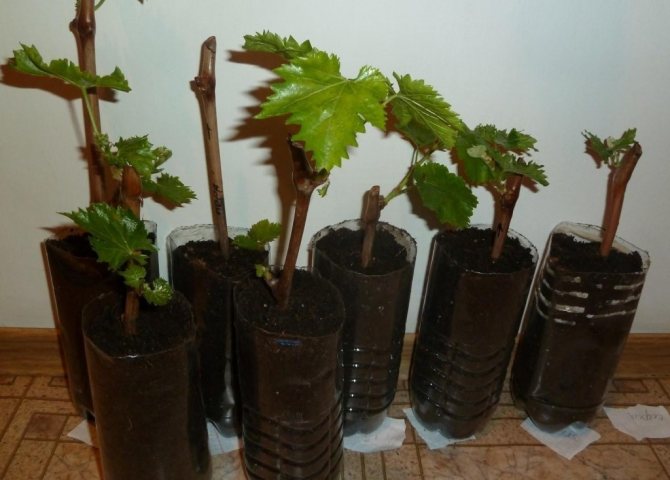

It is better to choose straight shanks so that they do not take up much space.
Chubuki - small pieces of vine with several developed buds. Before planting in open ground, they are pre-germinated in a room or greenhouse at a temperature of + 24 ... 26oC:
- The cut stems are placed in a weak solution of potassium permanganate for 3-4 hours. Then washed and dried.
- The upper and lower parts are cut by 1–2 cm and the shanks are placed in a solution of a root formation stimulator (Kornevin, Zircon) for 2–3 days.
- The last stage of germination is installation in clean water.
- The shanks are planted in open ground after the roots of 5–7 cm long have grown on them. The technology is similar to planting cuttings.
Cutting grapes on the window
Some gardeners plant cuttings on the windowsill at home. For this, the fertilized soil is poured into a plastic bottle cut from the top. And they leave it for a while to "charge" with solar energy in the light. Shoots are poured with water, covering only 1 peephole of the base.
The vessel is infused for a long time, roots begin to hatch in late autumn. Then only the cuttings must be planted in prepared containers with soil. The substrate must be loose. It is better to purchase ready-made soil in a gardening store, filled with the necessary composition of micro and macro elements.
How to care for a grape bush after planting
In the first year after the survival of the cuttings, the following activities are required:
- watering at least once a week. Depending on what the weather is like, the amount of moisture is proportionally reduced or increased.
- the shelter is carried out in the fall. Earth, sawdust, hay are used as a protective material, from above it is covered with a material that does not allow water (tarpaulin or polyethylene), and fixed with brackets.
- loosening is done after each watering. All work is carried out with the utmost care to avoid damage to the rhizome.
- the garter is carried out before the appearance of leaves and young shoots. The stems are tied to a trellis.
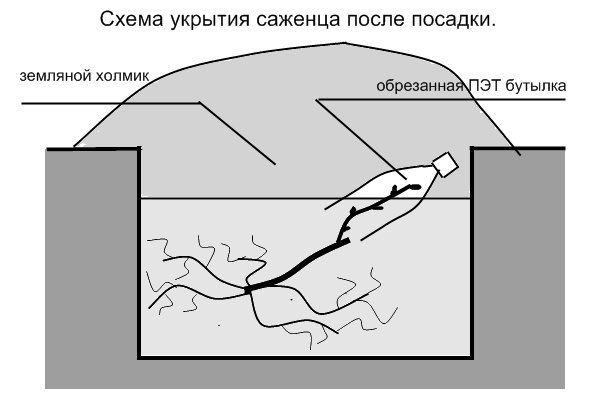

Shelter layout after landing
Helpful hints
Summing up, it is worth noting the typical mistakes made by novice growers when cutting grapes in autumn:
- Wrong choice of the time period for the rooting process. The formation of the root system sometimes lasts up to thirty days. With a longer rooting, the shanks begin to rot and are no longer suitable for planting.
- Violation of the temperature regime of storage of cuttings. The correct way to germinate cuttings is the ratio of the following temperature regime: the base of the cuttings has a higher degree of heating, the top requires a lower temperature. In the case of the opposite conditions, the eyes will first begin to develop, then the rhizome. The plant will wither to the point of death.
- Wrong way of rooting. Storing cuttings in winter spontaneously implies the return of moisture from the plants. Dried up shanks can become unusable in the future. For this reason, the shoot is initially soaked in water.
We were happy to share with you some recommendations for growing grapes at home. Every gardener has his own practical experience on this topic. Therefore, in the future, you can also keep your own archive with videos, photos, as well as records of growing grapes by cuttings in the fall.
Planting grapes in the fall: advantages and disadvantages
The positive aspects of rooting after the summer period include:
- the ability to choose healthy seedlings among many varieties;
- decrease in the number of waterings;
- easy survival;
- increased endurance.
The negative aspects of planting in the fall are associated with the death of plants during a harsh winter and sudden frosts due to incomplete rooting.


The vineyard is beautiful both in summer and autumn
Feeding unit for grapes
A feeding unit is necessary to supply water and fertilizer directly under the root of the grape bush. The use of a feeding unit makes the care of the grapes more efficient.
It is quite simple to make such a device. You need crushed stone or any other stone of a sufficiently coarse fraction, you can use brick chips and a pipe as long as the depth of the pit. Any pipe, a 50 mm plumbing pipe is well suited for this purpose. Stones or crushed stone must be placed in a polypropylene water-permeable bag, placed in a pipe and installed at the bottom of the pit. If there are a lot of stones, you can do without a bag and just pour 10-15 cm on the bottom of the pit. After that, fill the pit. The pipe should be approximately 10 cm above the ground. It is through this pipe that watering and feeding will be carried out in the future.
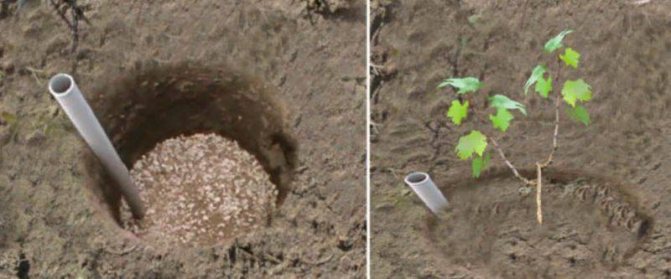

How to choose the right place for planting
Where is the best place to plant grapes? This is a very important question, since the safety and productivity of future bushes largely depends on the location of the planting. So you need to be very careful when choosing a place. Here are some helpful guidelines:
- The soil under the grapes should not be too alkaline or acidic. Sandy, rocky and even saline soil is best suited.
- Groundwater should not go higher than a meter to the ground surface. Otherwise, it is necessary to lay drainage on the bottom of the holes for disembarkation.
- The place must be protected from the wind. It is best to plant grapes near the wall of a building, a high solid fence or on a hillside.
- In order for the vine to get enough sun, it must grow on the south or southwest side.
- Rows of grapes, if many seedlings are planted, are arranged from north to south.
- The distance between the rows is 2.5-3 meters, and between the individual bushes - 2-3 meters. In this case, the roots will have room to grow, the grapes will begin to develop well.
Choosing the right place when planting grapes in autumn, as well as in spring, helps to ensure better survival of the bushes. In the future, such a vineyard will consistently bring good yields if it is properly cared for.
Growing grapes in different regions
Thanks to the warming climate and the unique plasticity of the vine, it is conquering more and more territories on the planet. Each area has its own climatic and soil characteristics. Having studied them, you can successfully grow grapes by choosing suitable varieties and agricultural techniques.


Cultural varieties of Amur grapes are successfully grown in the Far East
Table: the natural specifics of the regions and the peculiarities of planting grapes
| Region | Natural features | Landing features |
| Middle zone of Russia | The climate is moderately continental, frosty winters, warm, humid summers. | Spring planting with seedlings germinated in a warm room is preferable. |
| South of Russia | The climate is different: from subtropical (Black Sea coast) to sharply continental dry (Caspian region), from high-mountainous (Caucasus Mountains) to moderately continental (Dnieper steppes).In any case, the region is favorable for grapes, with hot summers and mild winters. | You can grow unpretentious grape varieties without shelter. Plants need to be planted at a distance of 3 m from each other and 3 m between the rows. |
| North of Russia | The North of Russia is large, the climate of different zones has its own characteristics. But the main obstacles for growing grapes in the north are short summers with a lack of the sum of active temperatures, long cold winters with thaws. Of the advantages of the north is the long duration of the sunshine. This is beneficial for increasing the yield and sugar content of the grapes. | It is necessary to select special varieties of very early and early ripening, winter-hardy and frost-resistant. Plants with Amur grapes among their ancestors live best here. Shelter is a must for the winter. |
| Caucasus | Warm humid climate, lots of sunshine. Thanks to this, the Caucasus is considered the birthplace of grapes. | Here the grapes do not need shelter, and you can choose any place for planting. |
| Black earth | The climate is moderately continental, there is a tendency towards aridity. The soils are fertile, light, warm well. | To determine the best time for planting grapes in the Central Black Earth Zone, you can focus on the blooming of birch leaves. If the tree leaves leaves, then the soil has warmed up to 10 ° C to a depth of 50 cm and grapes can be planted. |
| Primorye | Moderate monsoon climate. Winter is cold, dry and clear. Summers are humid and warm. The frost-free period lasts 150-200 days, so the grapes have time to ripen. The main plus for growing grapes is the duration of the sunshine receipt for more than 2000 hours. | To determine the time of planting grapes in Primorye, you need to focus on the budding of Amur grapes in the taiga. This usually happens from 5 to 20 May. You can plant grapes here only in spring. |
| Moscow suburbs | The climate is moderately continental. Winters are moderately cold with stable snow cover. Summers are moderately hot. | It is optimal to plant grapes in the spring and in the ridges. Saplings should be chosen from the first group of frost resistance (-35оС and above). Covering for the winter is mandatory. |
| Siberia | Continental climate, average annual positive temperature of 2100-2200 degrees. | For outdoor cultivation, choose super-early varieties. Better to grow in a greenhouse or covered trench. |
| Ural | The peculiarity of the Urals climate is short summers, which can be hot and dry, humid and cool. The temperature in the Urals in winter is from -16 ° C to -24 ° C. | It is best to plant grapes in a greenhouse and choose the earliest varieties. |
| Rostov region | The zone is characterized by insufficient moisture with increased solar activity. The winter problem is a sharp temperature drop, there are severe frosts. | Starting from the Rostov region, it is possible to plant grapes not only from the south side of buildings, but also from the west and east. But it is still necessary to provide protection from northern winds. |
| Tula region | Moderate continental: moderately cold winters, warm summers. The soils are mainly clay and loamy, unfavorable for grapes. | Landing only in pits filled with the necessary soil. It can be planted both in spring and autumn. Shelter is a must. |
| Voronezh region | The climate is moderately continental, the average temperature in January is -9оС, in July - 20оС. The climatic and soil conditions are suitable for growing grapes. | Early and super-early varieties are more reliable here. It is imperative to provide for the possibility of shelter from severe frosts and return frosts. |
| Kirov region | Continental climate. Moderately cold winters, warm summers. Winter lasts 4.5 months. The snow cover is significant. | A feature of the soils in the Kirov region is their increased acidity due to coniferous litter. Since grapes do not tolerate acidic soils, special attention should be paid to liming the soil. |
| Leningrad region | The main disadvantage of the climate is the high humidity of the air and soil. | Grapes do not like moisture, heat is not enough for them in the North-West, so it is better to plant them here in greenhouses or under cover. |
| Chelyabinsk region | The climate is continental, cold long winters, warm or hot summers. Chernozem and northern forest soils. The frost-free period is 90 days. Snow cover - up to 1 m. | It is better to make planting pits larger: 1x1x1 m. When filling the pit with soil, it is useful to use the bones of cattle, they are rich in phosphorus, which gives the grapes sweetness. For the winter, it is imperative to cover the grapes not only by insulating it, but also protecting it from moisture, that is, using a film. |
| Novosibirsk region | Continental climate. Harsh long winters with short thaws, short hot summers. The frost-free period is 120 days. | This area is characterized by recurrent frosts in spring and winter thaws. Therefore, it is imperative to use a shelter until mid-June and insulation with protection from dampness for the winter. |
| Krasnodar region | The main feature of the climate is an excess of sun with a lack of moisture. Soils are black earth, and gray forest podzolic, crushed stone, sandy. A favorable area for grapes. | A wide variety of varieties can be grown. Drip irrigation is preferred. The susceptibility to diseases of grapes is higher than in the northern regions. It is imperative to carry out disease prevention. |
| Khabarovsk region | Monsoon climate. Hot and rainy summers, severe, clear winters with little precipitation. | In the southern regions of the Khabarovsk Territory, cultural early grape varieties also ripen. Covering method of growing. |
| Bashkiria | The climate is continental, moderately hot summers, cold winters. The soils are poor, sandy or heavy clayey. | Plant only in spring, in May. It is imperative to prepare the landing pits well. |
| Tatarstan | Moderate continental climate. Warm summers, moderately cold winters. The soils are sod-podzolic, gray forest, black soil in the south. | Planting deep so that the roots do not freeze in winter. The pit must be at least 70 cm deep. The varieties should be chosen early and super early. |
| Vitebsk region | Continental climate with high rainfall. | It is better to plant grapes in ridges of 30-60 cm. Early varieties should be chosen. It is imperative to use a shelter. |
| Bulgaria | The climate is moderately continental, in the south it is Mediterranean. The soil is rich. The sum of active temperatures up to 4500 degrees. | Grapes have been grown here for centuries. Shelter is not required. Table varieties are grown. |
| North Kazakhstan | Sharply continental climate. Frosty winters, warm, windy summers. The soils are chernozems, brown and gray-brown. | For landing, you need to choose a place protected from the wind from the north and north-east sides. It is better to plant on the southern side of the buildings. |
| Tajikistan | The climate is dry and hot. Soils - light gray gray soils, sandy loam and loam. | Grapes are grown here traditionally and everywhere. Shelter is required in certain areas. Sweet table-raisin varieties are grown. |
| Germany | A temperate climate with an average temperature of 0 ° C in January and 20 ° C in July. The amount of precipitation per year is 600–1000 mm. Autumn is long and warm. The south of Germany is a favorable place for growing grapes. | Table grape varieties are grown on an industrial scale. In mountainous areas, grapes are planted with small aisles and grown in standard form. On the plains, trellises and wide aisles are used. |
In recent years, interest in growing grapes in northern latitudes has grown like never before. A rare gardener has not tried to tame a southern vine. The grapes turned out to be not such a bird of paradise in our area. With the right approach, he happily lives next to us. And it gives not only a tasty harvest, but also the joy of new discoveries, and the pleasure of earned success!
Post Views: 1
Vineyard care
After planting the seedlings, be sure to feed them. To do this, prepare a solution consisting of one liter of manure per bucket of water. The solution can be applied several times. And you can also feed with superphosphate and phosphorus-potassium fertilizers. In the future, all care will be to prepare the plantings for winter.
This issue is especially relevant in the regions of Siberia. It is necessary to create a shelter for grapes immediately after the first frost appears. Different materials can be used to protect the grapes from severe frost. For the root system, backfilling with peat, pine needles or sawdust mulch is suitable. For soil insulation, wooden boards, cardboard sheets, ordinary earth are suitable.
If you want to protect plantings from spring melt water, you can use roofing material or polyethylene. In Siberia, young plantings for the winter are covered with soil at least 30 cm high.When the first snow appears, it can be added to earth embankments. Before backfilling it is imperative to make sure that young bushes are dry.
So, cuttings are the most effective method for growing grapes in the fall. This is especially useful for beginner winegrowers to remember.
When to plant grapes and how to prepare seedlings?
To get juicy bunches of grapes, it is important to plant seedlings in a timely manner and adhere to agrotechnical rules for care.
The grapes grow well on light sandy soil, they love warmth and light. The culture is planted in light areas. 4–6 m recede from the trees. The plant is planted with vegetative seedlings or sprouted cuttings.
Chubuki are planted from early April to mid-May, when the soil warms up to + 8– + 10 ° C. A week before planting, the vine is examined. When cut, a healthy stalk is bright green in color and secretes liquid. The eyes do not fall off when pressed with a finger, and if an incision is made, the rudiments of the leaves are visible.
To prepare the cutting for planting, the lateral roots are removed on it, the central root is shortened to 25 cm. The young shoot is cut, leaving 3-4 buds. To replenish the moisture lost during storage, the cuttings are soaked in clean water for a day before planting.
Vegetable seedlings are planted from mid-May to mid-June. Each of them should have 3-4 healthy leaves, the height of the seedling is 50 cm. The dried or rotten ends of the roots are removed.
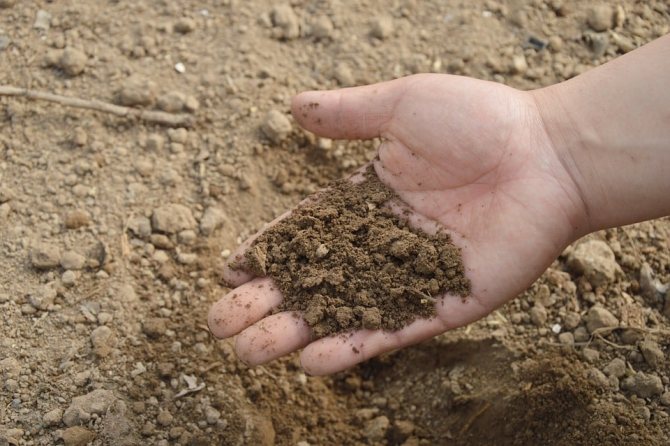

Photo:
The seedlings are hardened first for 3-4 hours under cover, gradually increasing the time spent outside. Further acclimatization is carried out under the open rays of the sun a week before disembarkation.
Autumn planting of grapes is carried out from the beginning of October until the first frost. To protect the seedlings from the cold, they are covered with plastic bottles for the winter, leaving holes for ventilation. The land around is watered abundantly, then loosened. Each bush is sprinkled with sawdust, leaves or grass cuttings.
For the development and growth of grapes, soil is of great importance. Clay soil is enriched with humus and sod soil. Sand and crushed stone are used as drainage. Before planting, the site is cleared of weeds, stones, tree roots, debris.
Shelter seedlings
After planting grapes in the fall, the young bush must be covered. Even in the south, this is required, since a young plant is especially sensitive to frost, its buds and roots die even at slight subzero temperatures, before springtime, they dry out in the cold winter wind. It is important to plant the seedlings on time, two weeks before frost, so that they have time to take root. The best time in the middle lane is the first and second ten days of October.
You can cover seedlings for the winter in different ways, here are the main ways:
- Plastic bottles. You just need to cut off the neck and dig a little bottle over the seedling. You can make several holes in it so that the vine can breathe.
- Fallen leaves, straw, reeds and spruce branches.These materials are free, they keep warm well, and turn into fertilizer in the spring.
- Tarpaulin, roofing felt, geotextile or film. More reliable, but also more expensive method than the previous two. It is convenient to use this method if there was a mass planting of grape seedlings in the fall.
- The ground. The seedling is simply buried in, the soil should be taken from the trench between the rows or from a neighboring plot. The disadvantage of this method is the frequent rotting of the kidneys and infection with fungal diseases.
Different concealment methods can be combined. For example, cover the seedling with a bottle, and sprinkle with straw on top. Cover young grapes with reeds or spruce branches before covering with earth. To prevent the branches from drying out, you can wax their upper part for the winter. Correctly covered grapes in spring will begin to develop rapidly and sprout, all buds will remain alive. If it is far from frost, the grapes are left open for several days for hardening. When late planting has been done, the vine is covered early.
How to properly plant a grape seedling in the fall, to what depth, how to cover it, you can watch a video or photo. This process is simple, if you have even the slightest experience. If you carefully study and follow the planting rules, planting bushes will be easy even for beginners. As a last resort, a beginner can always ask an experienced winegrower to show you how to plant shanks. When spring comes, the vine will not need any special additional care, it will begin to develop on its own. This is the huge advantage of autumn planting.

